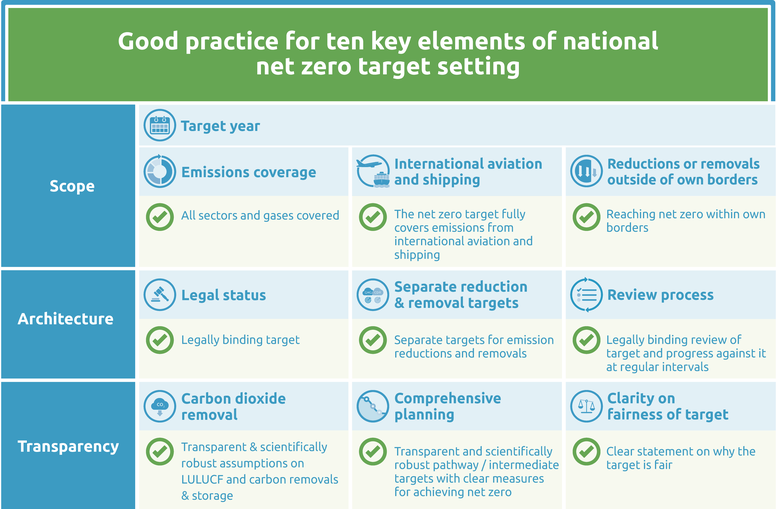Net zero targets
Summary
We evaluate the target as: Poor
In 2021, Türkiye announced a 2053 net zero target (Presidency of the Republic of Turkey, 2021).
Since then, Türkiye’s newly established Climate Council, composed of nearly 1,000 government officials, academics, business members, and NGOs, convened in February 2022 to develop a roadmap to meet the country’s 2053 net zero emission and green development targets (Hürriyet Daily News, 2022a). In June 2022, the Climate Council released their roadmap containing 217 decisions (Köksal & Kaya, 2022; Ministry of Environment, 2022). Notably, the roadmap mentions the creation of the National Green Finance Strategy, “Ulusal Yeşil Finans Stratejisi”, the development of national green taxonomy legislation, and the implementation calendar of the Emissions Trading System (Gundogmus, 2022). Though it stresses the need to increase renewable energy sources, it does not include the phase out coal power and stated that fossil gas exploration and production should be increased (Alp, 2022; Ministry of Environment, 2022).
Türkiye is also preparing a climate law, "İklim Kanunu", set to be completed by the end of this year (Gundogmus, 2022). The law is intended to help Türkiye meet its 2053 net zero emission target (Hürriyet Daily News, 2022b). The Grand National Assembly of Türkiye expects the climate law proposal to be on the agenda of the Parliament in the new legislative year (Grand National Assembly of Türkiye [Türkiye Büyük Millet Meclisi], 2022).
Incorporation of the Climate Action Tracker’s ten key good practice elements (see below) for net zero target design in Türkiye’s climate law would bolster the quality of Türkiye’s 2053 net zero target. In particular, the climate law could clearly state that the 2053 net zero target covers all GHG emissions in all sectors, includes both international aviation and shipping, and that net zero will be reached through domestic actions alone and not through the use international offset credits.
Türkiye is expected to submit an updated NDC as well as a long-term low greenhouse gas emission development strategy (LTS) by the end of this year (Daily Sabah, 2022a).
CAT analysis of net zero target
Ten key elements
Scope
- Target year – Türkiye aims to reach net zero by 2053.
- Emissions coverage – The roadmap produced by Türkiye’s Climate Council mentions methane and carbon dioxide but it is not clear whether all GHG emissions are covered. All sectors of the economy excluding international aviation and shipping, are covered by the roadmap but it does not provide quantified targets (Ministry of Environment, 2022; Presidency of the Republic of Turkey, 2021).
- International aviation and shipping – Türkiye provides no information on its intention to cover international aviation and shipping.
- Reductions or removals outside of own borders – It remains uncertain whether Türkiye intends to use international offset credits to meet its net zero target. Türkiye intends to include the legislation on offsetting by 2024 within the scope of its yet-to-be-established Emissions Trading System (Ministry of Environment, 2022).
Target architecture
- Legal status – Türkiye included its net zero target of 2053 in the roadmap developed by the country’s Climate Council in February 2022 (Ministry of Environment, 2022). Türkiye’s Climate Law, set to be completed by the end of this year, is intended to help Türkiye meet its 2053 Zero Emission Target (Gundogmus, 2022; Hürriyet Daily News, 2022b).
- Separate reduction & removal targets – Türkiye provides no information on its intention to communicate separate emission reduction and removal targets.
- Review process – Türkiye provides no information on its intention to establish a review cycle for its net zero and intermediate targets.
Transparency
- Carbon dioxide removal – Türkiye does not provide transparent assumptions on carbon dioxide removals.
- Comprehensive planning – Some information on anticipated pathway or measures for achieving net zero is available, but with limited detail. Türkiye’s Climate Council developed a roadmap to achieving its net zero target of 2053, which was released in June 2022 (Köksal & Kaya, 2022; Ministry of Environment, 2022). Türkiye is also expected to submit an updated NDC, as well as a long-term low greenhouse gas emission development strategy (LTS) by the end of this year (Daily Sabah, 2022a).
- Clarity on fairness of target – Türkiye makes no reference to fairness or equity in the context of its net zero target.
Good practice
The Climate Action Tracker has defined the following good practice for all ten key elements of net zero targets. Countries can refer to this good practice to design or enhance their net zero targets.
Further analysis
Latest publications
Stay informed
Subscribe to our newsletter





